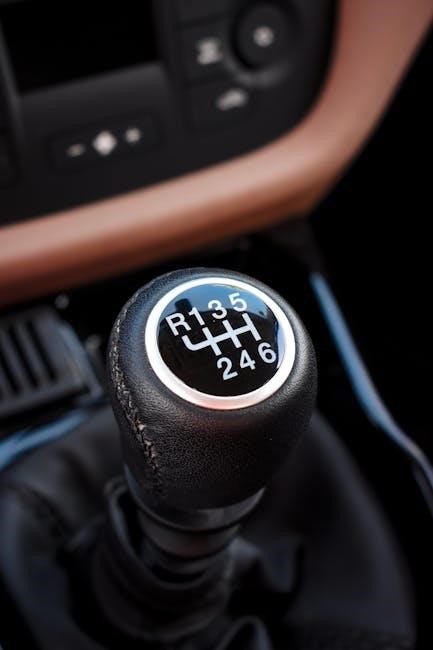Synchromesh manual transmission fluid is a specialized lubricant designed to optimize gear synchronization and smooth shifting in manual transmissions. It ensures efficient performance‚ reduces wear‚ and provides thermal stability‚ making it essential for maintaining transmission health and longevity.
1.1 Definition and Purpose
Synchromesh manual transmission fluid is a specialized lubricant designed to ensure smooth gear synchronization and efficient shifting in manual transmissions. It protects gears‚ bearings‚ and synchronizers from wear while maintaining optimal friction levels for precise shifting. Its purpose is to lubricate moving parts‚ dissipate heat‚ and prevent contamination‚ ensuring reliable transmission performance across varying temperatures and driving conditions. This fluid is specifically formulated to handle the unique demands of manual transmissions‚ providing durability and enhancing overall drivetrain efficiency.
1.2 Importance in Manual Transmissions
Synchromesh fluid is crucial for manual transmissions as it ensures smooth gear engagement and disengagement‚ reducing wear on synchronizers and gears. It prevents overheating‚ corrosion‚ and contamination‚ while maintaining optimal friction levels for precise shifting. Without it‚ transmissions would experience increased wear‚ reduced performance‚ and potentially catastrophic failure. Regular use of high-quality synchromesh fluid extends transmission life‚ enhances drivetrain efficiency‚ and ensures reliable operation under various driving conditions‚ making it essential for maintaining vehicle performance and longevity.

Composition and Types of Synchromesh Fluid
Synchromesh fluid is formulated with synthetic or conventional bases‚ enhanced with additives for friction control‚ wear protection‚ and thermal stability. It comes in various viscosity grades‚ catering to different climates and transmission demands‚ ensuring optimal performance across diverse operating conditions.
2.1 Synthetic vs. Conventional Fluids
Synthetic synchromesh fluids‚ like AMSOIL‚ offer superior anti-wear protection and longer service life compared to conventional fluids. They provide better low-temperature performance and oxidation stability‚ ensuring smoother gear shifts and reduced degradation over time. Conventional fluids‚ while cost-effective‚ may not perform as well in extreme conditions but are suitable for moderately loaded gears. The choice depends on vehicle demands and operating environments‚ with synthetic fluids being the preferred option for high-performance and durability needs.
2.2 Additives and Formulations
Synchromesh fluids contain specialized additives to enhance performance and protect components. Anti-wear agents reduce gear and bearing wear‚ while friction modifiers ensure smooth shifting by preventing excessive friction. Corrosion inhibitors protect metal parts from degradation. High-performance formulations may include antioxidants to resist fluid breakdown and dispersants to maintain cleanliness. These additives are carefully balanced to meet specific transmission requirements‚ ensuring optimal lubrication‚ compatibility‚ and durability. Customized formulations cater to varying vehicle demands‚ from everyday driving to high-stress conditions.
2.3 API GL Ratings and Certification
Synchromesh fluids often meet API GL ratings‚ which define performance standards for gear lubricants. Common ratings like GL-1‚ GL-2‚ and GL-3 indicate varying levels of protection against wear‚ corrosion‚ and heat. Certification ensures fluids meet rigorous testing standards‚ guaranteeing compatibility and performance in manual transmissions. Drivers should look for API-certified fluids to ensure reliability and avoid potential damage. These ratings help consumers select the right fluid for their vehicle’s specific needs‚ ensuring optimal transmission health and longevity.

Functions and Benefits of Synchromesh Fluid
Synchromesh fluid protects gears‚ ensures smooth shifting‚ and prevents wear. It enhances transmission performance‚ reduces friction‚ and maintains optimal synchronizer function‚ extending the lifespan of the gearbox.
3.1 Lubrication and Wear Protection
Synchromesh fluid provides exceptional lubrication‚ reducing friction between moving components like gears and bearings. It prevents metal-to-metal contact‚ minimizing wear and tear. The fluid also contains anti-wear additives that shield surfaces from damage‚ ensuring smoother operation and extending the lifespan of the transmission. By maintaining optimal lubrication‚ it prevents overheating and premature component failure‚ keeping the gearbox running efficiently and reliably over time.
3.2 Heat Dissipation and Oxidation Stability
Synchromesh fluid plays a crucial role in heat dissipation‚ preventing transmission components from overheating under heavy loads. Its advanced formulation resists thermal breakdown‚ maintaining viscosity even at high temperatures. Oxidation stability is enhanced through specialized additives‚ reducing the formation of deposits and sludge. This ensures the fluid remains effective longer‚ protecting the transmission from damage caused by heat and chemical degradation‚ and maintaining optimal performance across varying operating conditions.
3.4 Synchronizer Performance and Compatibility
Synchromesh fluid is specifically designed to enhance synchronizer performance‚ ensuring smooth and precise gear engagements; Its frictional properties help synchronize gear speeds effectively‚ reducing wear on synchronizer rings and hubs. The fluid’s compatibility with brass‚ steel‚ and other yellow metals prevents corrosion and premature wear. High-stress conditions during shifting are managed effectively‚ maintaining consistent performance and extending the lifespan of synchronizer components. Proper compatibility ensures seamless operation‚ making it vital for manual transmission reliability and durability.

Viscosity Grades and Temperature Range
Synchromesh fluid’s viscosity grade affects performance across temperatures. Thicker fluids are best for high heat‚ while thinner ones aid cold-weather shifting‚ ensuring lubrication and engagement.
4.1 Understanding Viscosity in Transmission Fluids
Viscosity in synchromesh fluid refers to its thickness and flowability‚ which affects how it performs under various conditions. Measured in centistokes (cSt)‚ viscosity determines the fluid’s ability to lubricate and engage gears smoothly. Lower viscosity fluids flow more easily in cold temperatures‚ while higher viscosity fluids provide better lubrication in heat. The ideal viscosity grade balances these factors‚ ensuring consistent performance across the transmission’s operating range without compromising synchronizer function or wear protection.
4.2 Recommended Viscosity for Different Climates
Viscosity recommendations vary based on climate and operating conditions. In colder climates‚ a lower viscosity fluid (e.g.‚ 5W-20) ensures easier gear engagement and smoother shifting. In hotter climates‚ a higher viscosity fluid (e.g.‚ 10W-30 or 15W-40) provides better lubrication and heat resistance. Always consult the manufacturer’s specifications to select the optimal viscosity grade for your vehicle’s manual transmission‚ ensuring proper performance and protection in your region’s temperature range.
Compatibility with Transmission Components
Synchromesh fluid must be compatible with all transmission components‚ including metals‚ seals‚ and gaskets. It prevents corrosion and wear while ensuring proper gear engagement and smooth operation.
5.1 Materials and Yellow Metals Compatibility
Synchromesh fluid is formulated to be compatible with a wide range of materials‚ including yellow metals like brass and bronze‚ which are commonly used in transmission components. It prevents corrosion and ensures proper engagement of gears and synchronizers. The fluid’s chemical composition is designed to protect these metals while maintaining lubrication and wear protection. Compatibility with yellow metals is crucial for maintaining the durability and performance of manual transmissions‚ especially in high-stress operating conditions.
5.2 Seals and Gasket Compatibility
Synchromesh fluid is specifically designed to maintain compatibility with transmission seals and gaskets‚ ensuring no swelling‚ hardening‚ or degradation of these components. Proper compatibility prevents leaks and maintains the integrity of the transmission system. The fluid’s formulation is balanced to work with materials like rubber and polyurethane‚ commonly used in seals‚ while avoiding harmful chemical reactions. This compatibility is essential for maintaining transmission performance and preventing mechanical failures over time.

Pouring and Filling Procedures
Use a funnel to pour synchromesh fluid‚ ensuring no spills. Locate the filler plug as per the manual. Fill to the recommended level‚ then replace the plug securely.
6.1 How to Pour Synchromesh Fluid Correctly
To pour synchromesh fluid correctly‚ gather a funnel‚ the fluid‚ and a clean cloth. Locate the transmission’s filler plug using your vehicle’s manual. Remove the plug and insert the funnel. Pour the fluid slowly‚ ensuring no spills. Stop occasionally to check the level with the dipstick. Avoid overfilling‚ as it can damage seals. Replace the plug securely and wipe any spills with the cloth. Always work in a well-ventilated area and wear protective gloves for safety.
6.2 Filling Levels and Safety Precautions
Proper filling levels are crucial for transmission performance. Always use a dipstick to verify the fluid level‚ ensuring it’s within the manufacturer’s recommended range. Overfilling can lead to seal damage and decreased efficiency. When handling synchromesh fluid‚ wear protective gloves and eyewear. Work in a well-ventilated area to avoid inhaling fumes. Dispose of used fluid responsibly‚ following local regulations. Consult your vehicle’s manual for specific filling instructions and safety guidelines.

Maintenance and Change Intervals
Regular fluid changes are essential for optimal performance. Most manuals recommend changing synchromesh fluid every 30‚000 to 60‚000 miles‚ depending on driving conditions.
7.1 Recommended Fluid Change Frequency
Synchromesh fluid should be changed every 30‚000 to 60‚000 miles‚ depending on driving conditions. Severe use‚ such as frequent stop-and-go traffic or extreme temperatures‚ may require more frequent changes. Always consult the vehicle’s owner’s manual for specific recommendations‚ as some manufacturers suggest longer intervals with synthetic fluids. Avoid exceeding the recommended interval to prevent wear on synchronizers and gears. Regular changes ensure optimal lubrication and performance. Using high-quality fluid can also extend the change interval and provide better protection.
7.2 Signs of Worn-Out Fluid
The fluid may darken in color or develop a gritty texture when worn out. A burning smell during driving can indicate degraded fluid. Transmission performance issues like slipping gears‚ slow shifting‚ or grinding noises often occur. If the fluid is contaminated or oxidized‚ it may fail to lubricate properly. Additional signs include increased engine RPM before shifting and difficulty engaging gears. These symptoms signal the need for a fluid change to prevent further damage to the transmission system.

Choosing the Right Synchromesh Fluid
Selecting the right synchromesh fluid involves checking viscosity‚ compatibility‚ and certifications. Consider climate‚ driving conditions‚ and manufacturer recommendations. Choose a reputable brand for optimal performance.
8.1 Factors to Consider in Fluid Selection
When selecting synchromesh fluid‚ consider viscosity‚ compatibility‚ and certifications. Ensure the fluid matches your transmission’s specifications and operating temperature range. Check for compatibility with materials like brass and steel. Look for API GL-4 certification to ensure it meets performance standards. Additionally‚ consider climatic conditions and driving habits‚ as these impact fluid performance. Always refer to your vehicle’s manufacturer recommendations for the most suitable option.
8.2 Top-Rated Products and Brands
Top-rated synchromesh fluids include Red Line MT-85/90‚ Amsoil Manual Transmission Fluid‚ and Castrol Syntrax Limited Slip. These brands are known for superior performance and durability. Red Line is popular for its high-performance formulas‚ while Amsoil offers excellent wear protection. Castrol is trusted for its compatibility with various transmissions. Lucas and Valvoline also provide reliable options. Royal Purple is another excellent choice‚ offering advanced lubrication technology. Always choose a reputable brand that meets your vehicle’s specifications for optimal performance.

Troubleshooting Common Issues
Common issues include grinding gears‚ hesitation‚ or sticking synchronizers. These often stem from low fluid levels‚ contamination‚ or incorrect viscosity. Always check fluid condition and levels first.
9.1 Symptoms of Incorrect or Degraded Fluid
Common symptoms include difficulty shifting gears‚ grinding noises‚ and hesitation during acceleration. Degraded fluid may cause slipping‚ locking‚ or erratic transmission behavior. Look for signs like discolored or milky fluid‚ foul odors‚ or excessive wear on synchronizers. If left unchecked‚ these issues can lead to premature transmission failure. Always monitor for these indicators to ensure optimal performance and longevity of your manual transmission system.
9.2 Diagnosing Transmission Problems
Diagnosing transmission issues often starts with a visual inspection of the fluid for degradation or contamination. Check for abnormal noises‚ such as grinding or clunking sounds‚ during gear shifts. Test the transmission’s performance by driving in different conditions to identify slippage or inconsistent shifting patterns. Ensure the fluid type matches the manufacturer’s specifications‚ as incorrect fluids can cause malfunctions. If issues persist‚ consult a professional or use specialized tools to pinpoint the root cause of the problem.

Environmental Considerations
Synchromesh fluid’s environmental impact includes biodegradability and toxicity. Proper disposal and recycling are crucial to prevent contamination. Eco-friendly formulations are increasingly being developed to reduce harm.
10.1 Eco-Friendly Fluid Options
Eco-friendly synchromesh fluids are made from bio-based or recycled materials‚ reducing environmental impact. These formulations are biodegradable and non-toxic‚ minimizing harm to ecosystems. Many manufacturers now offer sustainable options that meet performance standards while being environmentally responsible. Recycling programs for used fluid also contribute to reducing waste. Consumers can support eco-conscious brands by choosing these alternatives‚ ensuring safer disposal and less pollution. This shift aligns with global efforts to minimize automotive environmental footprint.
10.2 Proper Disposal Methods
Proper disposal of used synchromesh fluid is crucial to prevent environmental contamination. Drain the fluid into a sealed container and ensure it’s not mixed with other waste. Check local regulations for hazardous waste disposal sites. Many auto repair shops and recycling centers accept used transmission fluid. Never pour it down drains or mix it with household trash. Always use leak-proof containers to transport the fluid. Proper disposal protects groundwater and ecosystems from harmful chemicals. Follow community guidelines for responsible waste management.
Synchromesh manual transmission fluid plays an essential role in protecting and enhancing gearbox performance. Regular maintenance and correct practices ensure smooth shifting and long-lasting durability‚ benefiting overall transmission health.
11.1 Summary of Key Points
Synchromesh manual transmission fluid is crucial for smooth gear operation‚ wear protection‚ and heat management. It comes in synthetic and conventional types‚ with additives for enhanced performance. Proper viscosity selection based on climate ensures optimal function. Compatibility with transmission materials and seals is vital to prevent damage. Regular fluid changes and correct filling procedures maintain efficiency. Eco-friendly options and proper disposal methods support environmental sustainability. Always choose the right fluid for your vehicle to ensure long-term reliability and performance‚ adhering to manufacturer recommendations for best results.
11.2 Importance of Proper Fluid Maintenance
Proper maintenance of synchromesh fluid ensures optimal transmission performance‚ preventing wear and premature failure. Regular fluid checks and timely changes help maintain lubrication‚ reduce heat buildup‚ and prevent degradation. This extends the life of synchronizers and gear components. Neglecting maintenance can lead to costly repairs and reduced vehicle efficiency. Always adhere to manufacturer guidelines for fluid replacement to ensure smooth‚ reliable operation and protect your transmission from damage caused by friction and heat.

Further Reading and Resources
Consult manufacturer guidelines and online forums for detailed synchromesh fluid recommendations. Experts and enthusiasts often share valuable insights and tips for optimal transmission care and maintenance.
12.1 Manufacturer Recommendations
Always refer to your vehicle manufacturer’s guidelines for synchromesh fluid recommendations. They provide specific fluid specifications‚ such as viscosity grades and API GL ratings‚ to ensure compatibility and optimal performance. Check your owner’s manual or the manufacturer’s website for approved fluid lists. Using non-recommended fluids can lead to poor transmission performance or damage. Additionally‚ many manufacturers offer synthetic or high-performance options tailored to their transmissions. Adhere to these recommendations to maintain warranty coverage and ensure long-term reliability.
12;2 Online Forums and Expert Advice
Online forums and expert advice provide valuable insights into synchromesh fluid selection and maintenance. Enthusiasts and mechanics often share real-world experiences‚ offering tips on fluid compatibility‚ performance improvements‚ and troubleshooting. Platforms like Reddit’s automotive community or specialized transmission forums are excellent resources. Experts may also discuss optimal fluid viscosities for specific driving conditions. These communities can help users make informed decisions and avoid common pitfalls. Always verify advice with credible sources to ensure accuracy and safety.